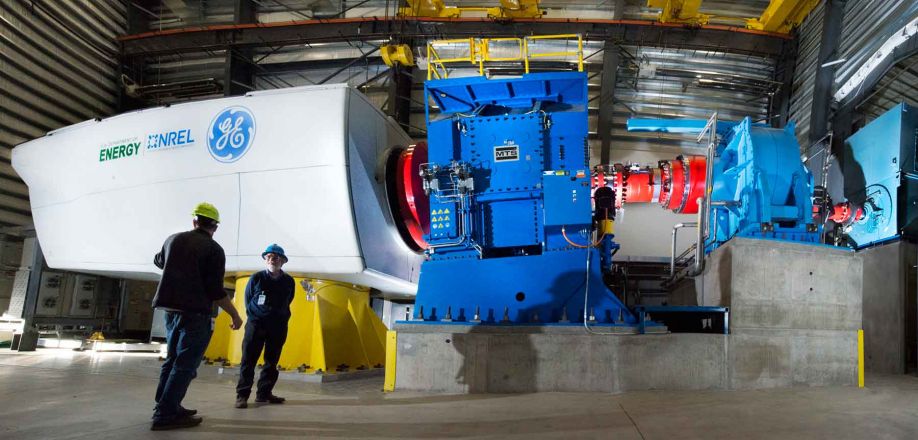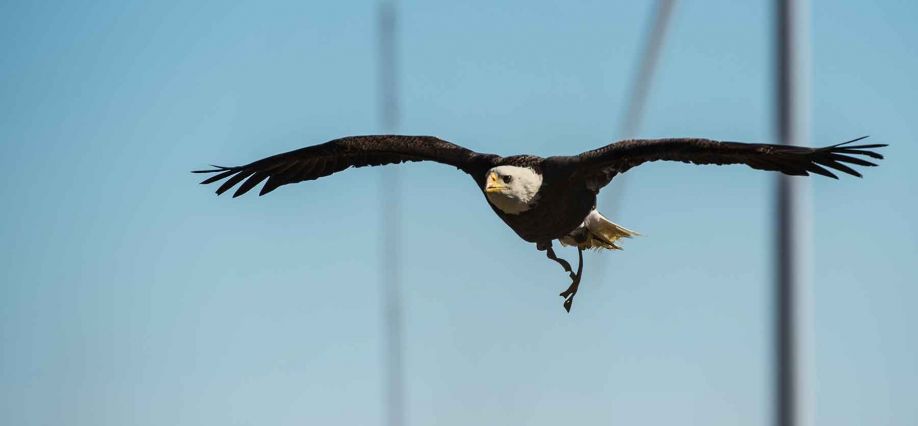NREL's ultimate goal in this testing is to foster the technological developments necessary for wider deployment of wind energy in the marketplace at the lowest cost possible.
David Glickson | NREL
Reprinted with permission from NREL's blog:
The National Wind Technology Center (NWTC), located at the base of the foothills just south of Boulder, Colorado, is the nation's premier wind energy technology research facility. Since the earliest days of wind energy, the center has provided an ideal environment for the research and development of advanced technologies.
Now, more than ever, as wind is expected to meet an ever-larger portion of our nation's energy needs, these efforts are critically important to meeting our future clean energy goals. Researchers at the Energy Department's National Renewable Energy Laboratory (NREL) are working with industry partners toward an energy future that features significant levels of reliable, affordable, and sustainable wind energy.
"The combination of our broad-based technical expertise along with our world-class capabilities and facilities has made us an indispensable resource for the wind industry," NWTC Director Daniel Laird said. "We are able to leverage this expertise and capability at the NWTC along with the depth of other technical experts at NREL and throughout the Energy Department's laboratory system to provide the wind industry with the fundamental physics-based understanding, high-performance computing enabled simulation tools, and physical validation necessary to significantly lower the cost of wind energy."

NREL Engineer Scott Lambert, left and Project Manager Mark McDade discuss calibrations being done on the dynamometer at the Dynamometer Test Facility at the NWTC. Photo by Dennis Schroeder, NREL
Better Gearboxes Make Better Wind Turbines
Premature failures of gearboxes, the mechanical equipment in a wind turbine that increases rotational speeds necessary for generators to produce electricity, have had a significant impact on the cost of wind turbine operations and the total cost of wind energy. Researchers at the NWTC, working with industry, have made tremendous strides in the quest for more reliable gearboxes.
NREL's 5-megawatt (MW) Dynamometer Test Facility allows NWTC engineers and their industry partners to verify the performance and reliability of wind turbine drivetrain prototypes and commercial machines. The dynamometer system replicates the rotor and blades of a wind turbine. The researchers can then control the turbine drivetrain's mechanical and electrical systems while simulating normal and extreme operating conditions.
"These machines are expected to operate reliably in the field, often in harsh conditions, for 20 years or more," NREL Dynamometer Project Manager Mark McDade said. "The ability to comprehensively test these systems in the lab, to verify their performance before they go into service, is a critically important capability for industry."
Conducting these tests before deployment is important because unanticipated failures can be detected and corrected early in the development process, leading to a lower cost of ownership for wind farm operators—and ultimately lower-cost wind energy for the consumer.
"The only way to deliver advanced technology at a lower cost of energy with high reliability is to be able to test and learn," GE Senior Manager for Wind Technologies Tom Fischetti said. "Being able to do that here at ground level instead of in the field, 300 feet in the air, is very important to GE and the rest of the wind industry."
Another step toward improved gearbox performance is the work being done by the Gearbox Reliability Collaborative (GRC). NREL initiated the GRC to better understand why many wind turbine gearboxes are not lasting as long as anticipated by manufacturers. The GRC applies a multi-pronged approach, combining analysis, field and laboratory testing, condition monitoring, and the development of a failure database, in its efforts to tackle this significant challenge for the wind industry.
"As the industry has matured, gearbox reliability has been a significant problem that has resulted in reduced performance and higher costs for the wind industry," NREL Senior Engineer Jonathan Keller said. "By working together in the GRC we have been able to assess the problem and identify solutions with our colleagues in a collaborative environment that is to the benefit of both the industry as a whole and general public."
NWTC engineers and their GRC industry partners have been able to identify shortcomings in the design, testing, and operation of wind turbines that contribute to reduced gearbox reliability. GRC findings are quickly shared among participants, including wind turbine manufacturers and equipment suppliers. Ultimately, the findings are made public for use throughout the industry. This knowledge is already resulting in increased gearbox reliability and an overall reduction in the cost of wind energy.
"The GRC is a significant program for wind turbine gearbox R&D worldwide, allowing for a collective sharing of knowledge for the wind industry that would not be possible otherwise," Romax Insight Global Vice President Ashley Crowther said. "It allows designers to validate modeling and analysis tools, test engineers to improve instrumentation capability and gearbox test programs, and researchers access to incredible test data. Without NREL's leadership in this collaborative we would continue to see higher failure rates for these components, leading to higher operations and maintenance costs for wind energy."

NREL Senior Engineer Pat Moriarty, left, and NREL Senior Engineer Paul Fleming review velocity (blue) and turbulence (yellow) in a simulation of the Lillgrund Wind Farm in Denmark. The researchers have written the open-source software tool Simulator for Wind Farm Applications (SOWFA), which can calculate how undulating ground, whipping blades, surface temperatures, and other variables alter the air flow and energy production at wind farms. Photo by Dennis Schroeder, NREL
Modeling a Smarter Wind Farm
The market for wind energy continues to grow—and so do the wind turbines and farms themselves. Unfortunately, the power production of these energy plants has, in some cases, been lower than initially predicted due to the ways that wind turbines interact with their surroundings and with one another in a wind plant. Wind plant underperformance has become a concern throughout the wind industry and could potentially cost developers millions of dollars over the typical life of a wind plant.
"The wind industry is concerned with these underperformance issues," NWTC Senior Engineer Pat Moriarty said. "The average underperformance is now about 1%–2%, but some farms are experiencing underperformance as high as 20%. This adds up to lost energy and high cost for the industry over the life of a wind plant—and presents NREL with a big opportunity to help improve wind plant efficiencies."
Improved efficiency can be realized with the help of an NREL-developed software tool called Simulator for Wind Farm Applications (SOWFA) that allows users to investigate the effects of weather patterns, turbulence, and complex terrain on the performance of individual wind turbines and entire wind plants.
SOWFA is the first tool that enables developers to improve the performance of not only one wind turbine, but the entire wind farm. And because of its open-source platform it is available for free to the wind industry. SOWFA simulates fluid dynamics on scales from regional weather to turbine wakes, and the impacts of these dynamics on turbine structural and system response. SOWFA also lets users simulate, through a central super-controller, coordinated multi-turbine control of wind plants.
Its improved look at the physics of wind energy is drawing significant interest from industry as companies seek to better understand how their wind turbines interact with local conditions and with one another, a key contributor to the performance, efficiency, and cost of wind energy.
"We have used SOWFA as a resource extensively for simulation of turbine wake interactions and for scientific investigation of wake losses under a variety of atmospheric conditions," Vestas Wind Systems Manager for Plant Flow Modeling Yavor Hristov said. "With its integrated approach to high-fidelity modeling, the SOWFA package is an important development for the wind industry as we continue to improve wind plant design and performance."

Spirit, a 20-year-old bald eagle, flies from a lift to his trainer at the NWTC. The Auburn University eagles, trainers and a veterinarian are participating in research to help NREL develop a radar and visual systems that prevent bird strikes with wind turbines. Photo by Dennis Schroeder, NREL
Making Wind Energy Safer for Wildlife
Collaborative research with industry and academic partners at the NWTC is seeking to make wind energy safer for birds.
NREL partnered with industry to gather data about bird flight patterns, which will help these companies develop technology to reduce bird collisions with wind turbines. The team of researchers recently conducted 25 flights and collected data using two trained eagles from Auburn University.
"We are working with our industry partners to collect data and continue to develop these technologies to the point where their systems can be deployed on wind farms and effectively reduce bird collisions," NREL Technical Engineer Jason Roadman said. "We want to see wind energy continue to grow, but we know that in order for that to happen we need to take every opportunity possible to reduce the environmental impacts of its deployment."
Two companies have avian detection systems installed at the NWTC, and both companies are benefitting from shared information. To gather the data, the birds carried a GPS logger, and their flights were conducted at various angles to the two detection systems. By comparing the GPS data collected with the results from the two avian detection systems, developers will be able to better characterize the behavior of their detection algorithms and improve their analysis methods.
"We can detect eagles at a thousand meters out and can instantly separate objects that are moving in the environment that are of interest, such as the eagle," said RES Americas Senior Vice President for Strategy Tom Hiester, one of the industry partners on the project. "It's a real-time identification system, and we can selectively shut down only the turbines that could come in contact with the bird, so we're also maximizing energy production."
"This is a great example of a partnership between NREL and the private sector to solve a problem in a way that is beneficial to everyone involved," said Laufer Wind President Eric Laufer, the other industry partner involved in the testing. "We were able to validate our detection systems in a controlled environment, before deploying at utility-scale wind farms."
NREL researchers hope to continue this project into the future by running similar tests with a variety of birds in order to collect even more data to use when refining the detection systems to track bird flight patterns.
Industry Collaborations Build a Bright Future for Wind Energy
These are but a few examples of how NREL researchers are focused on moving wind energy technologies forward. By continuing to lead the way in testing new technologies and being a trusted resource to the wind industry, the NWTC is a valued partner. These industry partnerships are critically important to meeting the nation's goals of moving toward a clean energy future.
NREL's ultimate goal in this testing is to foster the technological developments necessary for wider deployment of wind energy in the marketplace at the lowest cost possible. New wind turbine designs that are able to efficiently handle a wider regime of wind speeds and the ability to select technology that is optimized for a specific location and wind resource will allow greater deployment of wind energy in more areas where it may not have otherwise been practical.
"We are thrilled to have such a dynamic and diverse group of industry partners working with us to advance wind energy," Laird said. "These types of collaborations, leveraging our decades of experience and deep capabilities in wind energy research and development, demonstrate the NWTC's critical value to this global industry and to our energy future."
Learn more about NREL's National Wind Technology Center.
The content & opinions in this article are the author’s and do not necessarily represent the views of AltEnergyMag
Comments (0)
This post does not have any comments. Be the first to leave a comment below.
Featured Product


